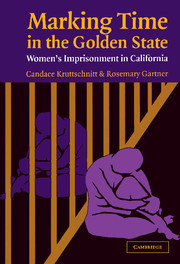Book contents
- Frontmatter
- Contents
- List of Figures and Tables
- Acknowledgments
- Marking Time in the Golden State
- 1 Introduction
- 2 Women, Crime, and Punishment in California
- 3 Entering the Prisons: Methods
- 4 Women's Experiences of Imprisonment at the California Institution for Women in the 1960s and the 1990s
- 5 Variations across Time and Place in Women's Prison Experiences
- 6 Negotiating Prison Life: How Women “Did Time” in the Punitive Era of the 1990s
- 7 Conclusion: The Spectrum of Women Prisoners' Experiences
- Appendix: Characteristics of Interviewees
- References
- Author Index
- Subject Index
1 - Introduction
Published online by Cambridge University Press: 15 December 2009
- Frontmatter
- Contents
- List of Figures and Tables
- Acknowledgments
- Marking Time in the Golden State
- 1 Introduction
- 2 Women, Crime, and Punishment in California
- 3 Entering the Prisons: Methods
- 4 Women's Experiences of Imprisonment at the California Institution for Women in the 1960s and the 1990s
- 5 Variations across Time and Place in Women's Prison Experiences
- 6 Negotiating Prison Life: How Women “Did Time” in the Punitive Era of the 1990s
- 7 Conclusion: The Spectrum of Women Prisoners' Experiences
- Appendix: Characteristics of Interviewees
- References
- Author Index
- Subject Index
Summary
this book describes a study of women's imprisonment in California in the early 1960s and the late 1990s, bridging a period that many scholars argue encompasses some of the most significant changes in penal policy during the last century. Although punishment in general and prisons as a central site of state punishment have long been subjects of both popular fascination and debate in democractic societies, this has been particularly true of the last few decades (see e.g., Beckett 1997; Garland 2001; Pratt 2002). In the United States, this period witnessed the fading of the rehabilitative ideal and the attendant view of the deviant as a product of poor socialization; the politicalization of crime – or what Simon (1997) calls “governing through crime” – and the widening of the criminal justice net to include not only a correctional apparatus anchored in community settings but also increasingly severe custodial sanctions (Bottoms 1983; Cohen 1985). While debate continues as to the precise nature and causes of these transformations in state control, and the most effective way of capturing or understanding these developments (Garland 2003), there is a consensus among scholars that the landscape of criminal punishment was very different at the end of the twentieth century than it had been only four decades earlier.
These changes, both in policy and in practice, have had profound consequences for female offenders.
- Type
- Chapter
- Information
- Marking Time in the Golden StateWomen's Imprisonment in California, pp. 1 - 7Publisher: Cambridge University PressPrint publication year: 2004



